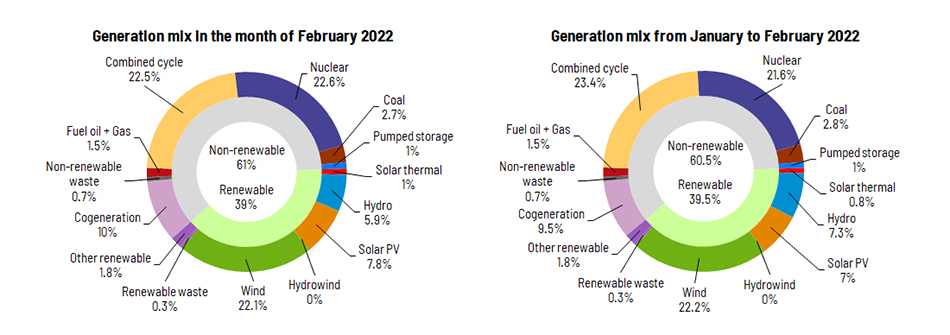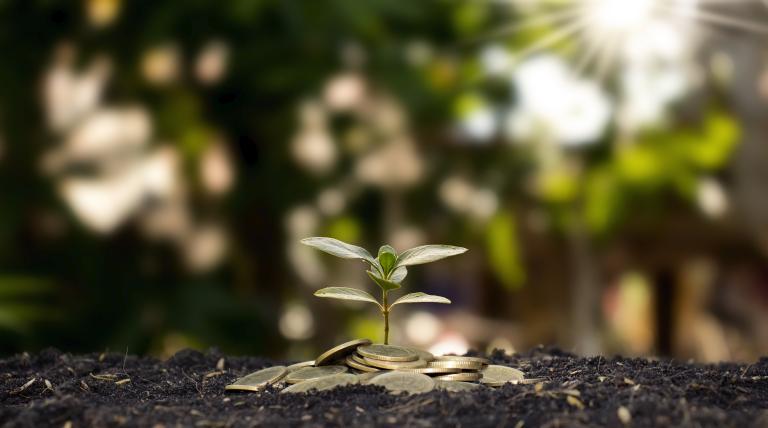We are a global operator of essential infrastructure
- 39% of monthly generation came from renewable sources and 62.2% was obtained using technologies which produce zero CO2 equivalent emissions.
- Solar photovoltaic energy experienced strong growth in February and produced 69.1% more.
- Electricity demand increased by 10.2% in the Balearic Islands and 14.4% in the Canary Islands compared to February 2021.
National electricity demand in February is estimated at 20,190 GWh, a value that is similar to the figure registered in the same month of 2021 (20,182 GWh) and is basically unchanged from February last year. After having factored in the influence of seasonal and working patterns, the figure is 0.5% higher than in February last year.

In the first two months of 2022, demand is estimated at 42,891 GWh, 2.7% lower than in 2021. Once again, after having factored in the influence of seasonal and working patterns, the demand is 1.5% lower than in the previous year.
In the month of February, and according to data estimated at the time of this press release, generation from renewable energy sources accounted for 39% of the national production. Regarding energy obtained using technologies which produce zero CO2 equivalent emissions (GHG), this accounted for 62.2% of the total mix.
Wind power generation in February reached 4,063 GWh and accounted for 22.1% of production nationwide, behind nuclear and combined cycle, which with 22.6% and 22.5%, respectively were the leading technologies in the overall generation mix for the month.
Solar photovoltaic, with a share of 7.8%, ranked as the fourth technology in the generation mix, increasing its production to 1,647 GWh, a value that is 69.1% higher compared to February 2021. This is the best figure recorded by this technology since October 2021 and represents a notable growth if we take into account that February only has 28 days and that there are not yet many hours of daylight.

Demand for electrical energy in the peninsular electricity system fell 0.6%
Demand for electrical energy in the mainland electricity system in February is estimated at 19,100 GWh, down 0.6% on the figure registered in February 2021. After having factored in the influence of seasonal and working patterns, demand remained unchanged compared to the same month of last year.
In the first two months of 2022, electricity consumption on the Spanish mainland is estimated at 40,590 GWh, 3.3% less than in 2021. In this case, after having factored in the influence of seasonal and working patterns, the figure is 2% lower than that recorded in the same period last year.
During February, and according to data estimated at the time of this press release, 40.4% of the generation on the Spanish mainland came from renewable sources and 64.9% was obtained using technologies which produce zero CO2 equivalent emissions. Wind energy was responsible for the production of 4,572 GWh and accounted for 22.8% of electricity generation mix, a share only surpassed by nuclear, which led the mix with 23.8% of the total. Combined cycle (20.7%), solar photovoltaic (8%) and hydro (6.3%) completed the ranking of the five technologies that generated the most during this month.
On 22 February at 12:41 pm, instantaneous power from solar photovoltaic generation exceeded 10,000 MW for the first time ever in the mainland electricity system and registered a new all-time record of 10,024 MW (32.1% of the demand at that time). This new record is 1% higher than the previous all-time high, recorded just one day earlier, at 2:47 pm and reached 9,925 MW.
The sum of solar photovoltaic and solar thermal energy generation also reached its highest peak on 22 February at the same time, when 11,663 MW of instantaneous solar power was produced. The production of solar energy as a whole represented 37.2% of the peninsular demand at that time.
Demand for electricity in February increased 10.2% in the Balearic Islands and grew 14.4% in the Canary Islands
In the Balearic Islands, the demand for electricity in February is estimated at 398,464 MWh, a value that is 10.2% higher than that recorded in the same month last year. After having factored in the influence of seasonal and working patterns, the figure is 8.6% down on that recorded in February 2021.
In the first two months of 2022, the demand on the Balearic Islands, in gross terms, is estimated at 862,911 MWh, a value that represents an increase of 3.6% compared to the same period in 2021.
In terms of overall generation, combined cycle, with 82.3% of the energy produced in the Balearic Islands, was the leading technology used in the archipelago in February. Thus, clean and renewable energy technologies used in the Balearic Islands accounted for 6.2% of the total generation mix. Furthermore, during this month the submarine link between the mainland and Majorca helped cover 6.9% of the electricity demand in the Balearic Islands.
Regarding the Canary Islands, electricity demand is estimated at 659,499 MWh, up 14.4% on that recorded in February 2021. After having factored in the influence of seasonal and working patterns, the figure is 14% higher than that registered in the same month last year.
In the first two months of 2022, the demand in the Canary Islands, in gross terms, is estimated at 1,372,557 MWh, 12.1% more than in 2021.
Regarding electricity generation in the Canary Islands, combined cycle, with 45.1% of the total, was also the leading technology in February, while renewables and technologies which produce zero CO2 equivalent emissions accounted for 16.9% of the total production.
Consult our Daily Balance Report for more information on the National, Peninsular, Balearic Islands and Canary Islands electricity systems as at the close of February.














